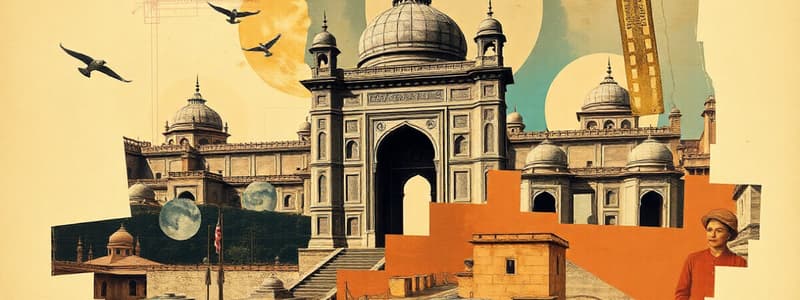Podcast
Questions and Answers
Maharaja Hari Singh's kingdom governed Jammu and Kashmir only after independence in 1947.
Maharaja Hari Singh's kingdom governed Jammu and Kashmir only after independence in 1947.
False (B)
The period after independence in Jammu and Kashmir saw only continuity with no visible change.
The period after independence in Jammu and Kashmir saw only continuity with no visible change.
False (B)
Jammu's history after independence is isolated from the broader political and social shifts in the Indian subcontinent.
Jammu's history after independence is isolated from the broader political and social shifts in the Indian subcontinent.
False (B)
Jammu's development path has been unaffected by its location and historical connections with other regions.
Jammu's development path has been unaffected by its location and historical connections with other regions.
Modern history in Jammu is characterized by complete resolution of all socio-economic challenges.
Modern history in Jammu is characterized by complete resolution of all socio-economic challenges.
The early history of Jammu is distinct and separate from the history of the broader region.
The early history of Jammu is distinct and separate from the history of the broader region.
The Kushan dynasty never exerted any influence in the Jammu region.
The Kushan dynasty never exerted any influence in the Jammu region.
The Katoch dynasty was one of the Rajput clans that played a significant role in the region.
The Katoch dynasty was one of the Rajput clans that played a significant role in the region.
Mughal control over Jammu was consistently strong and without resistance from local rulers.
Mughal control over Jammu was consistently strong and without resistance from local rulers.
The Dogra dynasty emerged as a significant power in the 14th and 15th centuries.
The Dogra dynasty emerged as a significant power in the 14th and 15th centuries.
The Dogra rule had no impact on Jammu’s relationship with neighboring regions like Kashmir.
The Dogra rule had no impact on Jammu’s relationship with neighboring regions like Kashmir.
The Dogra era saw no significant changes in infrastructure development in the region.
The Dogra era saw no significant changes in infrastructure development in the region.
British influence over Jammu and Kashmir came without any conflict with local kingdoms.
British influence over Jammu and Kashmir came without any conflict with local kingdoms.
Flashcards
Maharaja Hari Singh
Maharaja Hari Singh
Ruler of Jammu and Kashmir during the 1947 independence.
Independence and Jammu
Independence and Jammu
The period after 1947 saw significant changes in Jammu's political landscape.
Regional Conflicts
Regional Conflicts
Various political and social conflicts impacting Jammu's development.
Communal Coexistence
Communal Coexistence
Signup and view all the flashcards
Economic Development in Jammu
Economic Development in Jammu
Signup and view all the flashcards
Early History of Jammu
Early History of Jammu
Signup and view all the flashcards
Indo-Greek Influence
Indo-Greek Influence
Signup and view all the flashcards
Rajput Clans
Rajput Clans
Signup and view all the flashcards
Mughal Empire Influence
Mughal Empire Influence
Signup and view all the flashcards
Local Rulers' Allegiance
Local Rulers' Allegiance
Signup and view all the flashcards
Dogra Dynasty Emergence
Dogra Dynasty Emergence
Signup and view all the flashcards
Maharaja Gulab Singh
Maharaja Gulab Singh
Signup and view all the flashcards
British Colonial Influence
British Colonial Influence
Signup and view all the flashcards
Study Notes
Early History and Kingdoms
- Jammu's early history is intertwined with the broader history of the region, encompassing various empires and dynasties.
- Evidence suggests the presence of settlements and civilizations in the area dating back to ancient times.
- The region witnessed the influence of the Indo-Greek, Kushan, and other regional powers.
- Over time, different kingdoms emerged and exerted control over various parts of the region, including the region now known as Jammu.
- Historical accounts detail the growth and decline of these kingdoms, often influenced by conflicts and alliances. This included the rule of various Rajput clans, like the Katoch dynasty, that played a significant role.
Mughal Rule
- The Mughal Empire's influence significantly shaped the political landscape of Jammu.
- The Mughals expanded their control over the region, often through military campaigns and political alliances.
- Jammu, under various local rulers who often pledged allegiance to the Mughals, transitioned under different forms of Mughal control.
- The era saw both periods of relative peace and conflict, affecting the culture and economic activities within the region.
- The Mughals' control over Jammu was sometimes tenuous, marked by resistance from local rulers.
Dogra Rule
- The Dogra dynasty emerged as a significant power in the 18th and 19th centuries.
- Initially, local rulers were frequently involved in inter-kingdom disputes. Later, during the ascendance of the Dogra rule, this became more stable and influenced Jammu’s relationship with neighboring regions like Kashmir, which became closely aligned.
- The Dogras played a key role in the region's administration and development, marking a distinct period in Jammu's history.
- The Dogra rule, established under Maharaja Gulab Singh, significantly shaped Jammu's governance, infrastructure, and social fabric.
- The Dogra era included advancements in infrastructure development, and saw a gradual transformation in the region.
British Period and Later Developments
- Following prolonged conflicts between the British East India Company and different local kingdoms, the British established considerable influence over Jammu and Kashmir.
- The period brought both challenges and opportunities for Jammu.
- The region’s integration into the British colonial empire marked a significant shift in political relations.
- Jammu and Kashmir were governed by Maharaja Hari Singh’s kingdom in the period immediately preceding and following independence in 1947, with impacts on the subsequent shape of the region.
- The period after independence saw further development and transformation in the region, with both continuity and change.
- The history of Jammu after independence reflects broader political and social shifts in the Indian subcontinent.
Regional Conflicts and Developments in Modern Times
- Jammu has been significantly impacted by various political and social conflicts involving neighboring regions.
- The region’s location and historical connections with other areas in the region have significantly shaped its development path.
- Different forms of communal coexistence and conflict have influenced the region's social and political landscape.
- Modern history is characterized by continued efforts to develop the region and address challenges relevant to the society.
- Diverse factors, including economic development and social changes, have played a role in recent history.
Studying That Suits You
Use AI to generate personalized quizzes and flashcards to suit your learning preferences.




